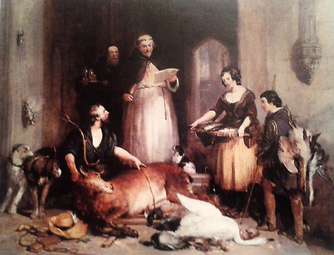Return of the Hunters, Bolton Woods
|
Research by Jacqueline Arundel & Marjorie Gregson
Acc No 65 Artist Sir Edwin Henry Landseer RA (after) Artist dates 1802-1873 Medium Jacquard Tapestry Size unknown Date produced unknown Donor Miss Margaret Burdekin (1868-1944) or Miss Elizabeth Burdekin (1869-1958) Dean, Preston New Road, Blackpool Date donated 28 July 1941 Also in the Collection: Artist : Sir Edwin Henry Landseer RA (after) Engraver: Thomas Landseer, c.1794-1880 Braemar acc no 137 Monarch of the Glen acc no 107 The Ptarmigan Hill acc no unknown Stag and Deer (A Deer Family) acc no 110 |
|
Jacquard Tapestry, after Sir Edwin Henry Landseer RA (1802-1873), engraver, painter, sculptor and lithographer. He was the great-nephew of Gainsborough, famed for his scenes of animals and as the sculptor of the lions in Trafalgar Square, London.
This image is not of the tapestry in the Collection but a representation of the painting that it was based on. Bolton Abbey in the Olden Time is the painting's known title, painted in 1814 and held at Chatsworth. It is one of Landseer's most celebrated compositions, exhibited at the Royal Academy in 1834. An historical composition, one of only a few history paintings done by Landseer, and unusual in that all the portraits were painted from life. William Cavendish, 6th Duke of Devonshire, who at the time of painting owned Bolton Abbey, commissioned the painting. The Duke was expecting a representation of the Abbey and not a romantic vision of the past but was reconciled when the painting achieved great success. The composition emphasises the contrast between the refined secluded world of the abbey and the vitality of the local country folk who have brought a variety of game as an offering. We have many engravings by Landseer in the Collection; it was due to the dissemination of these engravings that he became popular and well-known. (1) DONORS Three sisters were born in Lytham to architect, George William Burdekin (1832-1875) and his wife, Elizabeth, nee Bamber (1843-1915). Margaret (1868-1944), Elizabeth (1869-1958) and Edith (1872-1907) remained on the Fylde all their lives and never married. It is not known which of the two elder Burdekin sisters donated the Jacquard Tapestry Return of the Hunters, Bolton Woods (after Sir Edwin Henry Landseer). The 1871 census records George and his family as residing in Bannister Street; a servant made up the household. At this time his occupation, although he was only 39, was described as 'retired architect and landowner'. George died, aged 43, in 1875 and was buried at St Cuthbert’s, Lytham. His death was reported in the Preston Chronicle on the 27 March 1875. In 1881 his widow was residing with her daughters at 5 Beach Street, Lytham, living off private means. In 1891 Mrs Burdekin had taken up employment and was described on the census as a 'fancy dealer and outfitter', as were both Elizabeth and Edith. At that time they were living in Park Road, Blackpool. When Edith's died in 1907 her funeral was well attended with the names of all the mourners being listed in the newspaper. By 1901, Elizabeth was living on her 'own means' with Edith and an aunt at 15 Park Road. Her elder sister, Margaret, was living at Moorlands, Garstang Road, Preston, a private school, where she boarded as a teacher. In 1911, by which time Edith had died, Margaret and Elizabeth were living at the address in Park Road, with Margaret's occupation still being recorded as 'governess'. Mrs Burdekin married Reverend Canon Norman Stuart Jeffrey (1833-1919) of St John's Church, Blackpool in 1899; he retired in 1915 after 46 years service. When Elizabeth died in February 1915 there were several articles in the press about her work for the church. Probate was granted to Margaret and Elizabeth. |
REFERENCES
(1) Smith, A & Stewart, A, (1995), The Harrogate Fine Art Collection, Harrogate Museums and Arts (2) www.findmypast.co.uk (3) www.ancestry.co.uk |

